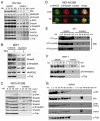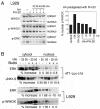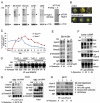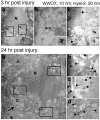Hyaluronan activates Hyal-2/WWOX/Smad4 signaling and causes bubbling cell death when the signaling complex is overexpressed
- PMID: 27845895
- PMCID: PMC5386674
- DOI: 10.18632/oncotarget.13268
Hyaluronan activates Hyal-2/WWOX/Smad4 signaling and causes bubbling cell death when the signaling complex is overexpressed
Abstract
Malignant cancer cells frequently secrete significant amounts of transforming growth factor beta (TGF-β), hyaluronan (HA) and hyaluronidases to facilitate metastasizing to target organs. In a non-canonical signaling, TGF-β binds membrane hyaluronidase Hyal-2 for recruiting tumor suppressors WWOX and Smad4, and the resulting Hyal-2/WWOX/Smad4 complex is accumulated in the nucleus to enhance SMAD-promoter dependent transcriptional activity. Yeast two-hybrid analysis showed that WWOX acts as a bridge to bind both Hyal-2 and Smad4. When WWOX-expressing cells were stimulated with high molecular weight HA, an increased formation of endogenous Hyal-2/WWOX/Smad4 complex occurred rapidly, followed by relocating to the nuclei in 20-40 min. In WWOX-deficient cells, HA failed to induce Smad2/3/4 relocation to the nucleus. To prove the signaling event, we designed a real time tri-molecular FRET analysis and revealed that HA induces the signaling pathway from ectopic Smad4 to WWOX and finally to p53, as well as from Smad4 to Hyal-2 and then to WWOX. An increased binding of the Smad4/Hyal-2/WWOX complex occurs with time in the nucleus that leads to bubbling cell death. In contrast, HA increases the binding of Smad4/WWOX/p53, which causes membrane blebbing but without cell death. In traumatic brain injury-induced neuronal death, the Hyal-2/WWOX complex was accumulated in the apoptotic nuclei of neurons in the rat brains in 24 hr post injury, as determined by immunoelectron microscopy. Together, HA activates the Hyal-2/WWOX/Smad4 signaling and causes bubbling cell death when the signaling complex is overexpressed.
Keywords: Hyal-2; Smad; WWOX; hyaluronan; hyaluronidase.
Conflict of interest statement
The authors declare no conflicts of interest.
Figures










Similar articles
-
HYAL-2-WWOX-SMAD4 Signaling in Cell Death and Anticancer Response.Front Cell Dev Biol. 2016 Dec 6;4:141. doi: 10.3389/fcell.2016.00141. eCollection 2016. Front Cell Dev Biol. 2016. PMID: 27999774 Free PMC article. Review.
-
Transforming growth factor beta1 signaling via interaction with cell surface Hyal-2 and recruitment of WWOX/WOX1.J Biol Chem. 2009 Jun 5;284(23):16049-59. doi: 10.1074/jbc.M806688200. Epub 2009 Apr 14. J Biol Chem. 2009. PMID: 19366691 Free PMC article.
-
Chasing the signaling run by tri-molecular time-lapse FRET microscopy.Cell Death Discov. 2018 Mar 22;4:45. doi: 10.1038/s41420-018-0047-4. eCollection 2018. Cell Death Discov. 2018. PMID: 29581896 Free PMC article.
-
Hyaluronan: An Architect and Integrator for Cancer and Neural Diseases.Int J Mol Sci. 2025 May 27;26(11):5132. doi: 10.3390/ijms26115132. Int J Mol Sci. 2025. PMID: 40507943 Free PMC article. Review.
-
A p53/TIAF1/WWOX triad exerts cancer suppression but may cause brain protein aggregation due to p53/WWOX functional antagonism.Cell Commun Signal. 2019 Jul 17;17(1):76. doi: 10.1186/s12964-019-0382-y. Cell Commun Signal. 2019. PMID: 31315632 Free PMC article.
Cited by
-
Functional role of WW domain-containing proteins in tumor biology and diseases: Insight into the role in ubiquitin-proteasome system.FASEB Bioadv. 2020 Feb 21;2(4):234-253. doi: 10.1096/fba.2019-00060. eCollection 2020 Apr. FASEB Bioadv. 2020. PMID: 32259050 Free PMC article.
-
Strategies by which WWOX-deficient metastatic cancer cells utilize to survive via dodging, compromising, and causing damage to WWOX-positive normal microenvironment.Cell Death Discov. 2019 May 21;5:97. doi: 10.1038/s41420-019-0176-4. eCollection 2019. Cell Death Discov. 2019. PMID: 31123603 Free PMC article.
-
PMF-GRN: a variational inference approach to single-cell gene regulatory network inference using probabilistic matrix factorization.Genome Biol. 2024 Apr 8;25(1):88. doi: 10.1186/s13059-024-03226-6. Genome Biol. 2024. PMID: 38589899 Free PMC article.
-
WW-Domain Containing Protein Roles in Breast Tumorigenesis.Front Oncol. 2018 Dec 13;8:580. doi: 10.3389/fonc.2018.00580. eCollection 2018. Front Oncol. 2018. PMID: 30619734 Free PMC article. Review.
-
WWOX Possesses N-Terminal Cell Surface-Exposed Epitopes WWOX7-21 and WWOX7-11 for Signaling Cancer Growth Suppression and Prevention In Vivo.Cancers (Basel). 2019 Nov 19;11(11):1818. doi: 10.3390/cancers11111818. Cancers (Basel). 2019. PMID: 31752354 Free PMC article.
References
-
- Stern R. Devising a pathway for hyaluronan catabolism: are we there yet? Glycobiology. 2003;13:105r–15r. - PubMed
-
- Schmaus A, Bauer J, Sleeman JP. Sugars in the microenvironment: the sticky problem of HA turnover in tumors. Cancer Metastasis Rev. 2014;33:1059–79. - PubMed
-
- Frost GI, Mohapatra G, Wong TM, Csoka AB, Gray JW, Stern R. HYAL1(LUCA-1), a candidate tumor suppressor gene on chromosome 3p21.3, is inactivated in head and neck squamous cell carcinomas by aberrant splicing of pre-mRNA. Oncogene. 2000;19:870–7. - PubMed
MeSH terms
Substances
LinkOut - more resources
Full Text Sources
Other Literature Sources
Molecular Biology Databases
Research Materials
Miscellaneous

